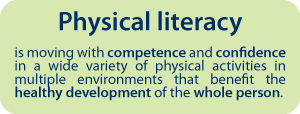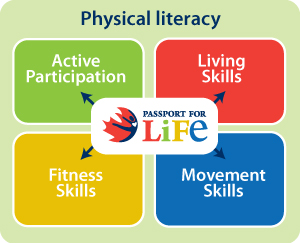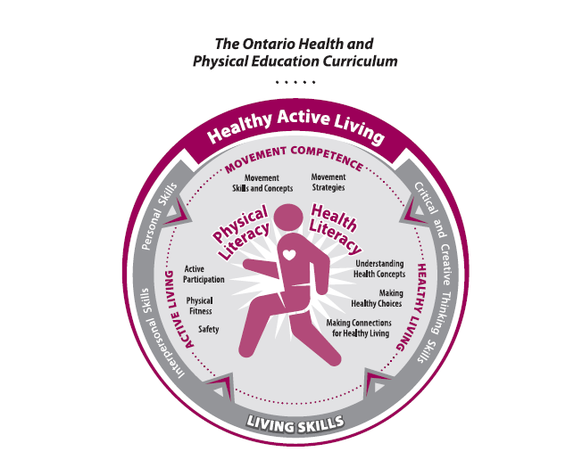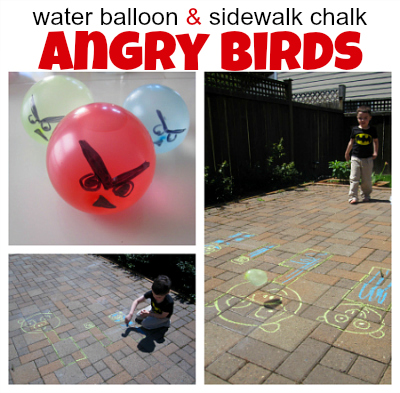Thanks to all the amazing ideas from Pinterest, I was able to come up with an initial list of play day ideas for this year! This is our first year having the whole school take part in play day (Grade 8's selected and ran the stations from the list below as well as running the play groups: grades 1-2 (block 1), grades 3-5 (block 2), grades 6-7 (block 3)...balanced day!) Each grade group had a block of time to move around our 10 selected stations!
1. ‘Rest’ Water Station: We did the following at our rest station - Tic-Tac-Toe Yoga Fit; Character Building Activity ("Who is your superhero?"); Chalk; Duck Tape bracelets; Freezes (sold freezes for $1).
- Tic-Tac-Toe Fitness: Yoga and Active Start Charts from Thompson Publishing . You can use any type of fitness activity in each square. Students alternated taking turns placing their 'move' on the tic-tac-toe board and held their move until the game was finished (i.e., 3 in a row vertically, horizontally, or diagonally).
 |
| Tic-Tac-Toe Yoga Fit |
- Who is your superhero? Tell why using one of the character building words posted on the wall? Students picked one of the character building words our school community focussed on this year and connected ONE word to their selected superhero and wrote it on mural paper! Great community building activity!
 |
| Who is your superheo: Character Builds... |
- Duck Tape Bracelets! Each students received a duck tape bracelet inspired by the "Go Girls Day" held by HWDSB in June. A crew of students help to make 700 bracelets for each student to take home!
 |
| Duck Tape Bracelets |
 |
| Fun Duck Tape! |
2.
Mega Target Frisbee Throw: Just purchased these target mats and they are amazing, durable, and can be used for ultimate frisbee golf (#18)...or as part of any kind of relay such as Mega Target Frisbee Throw.
3.
Bucket Toss: Line up 5 labelled buckets, with number 1 closest to
toss line and number 5 furthest away.
Each person receives 5 plastic golf balls or 5 turns. Have two sets of buckets for both teams.
4.
Sponge Toss: If it is a hot day this is a very popular
race. Each team needs two buckets of water and two large sponges. Each team
lines up with a bucket of water at the front of the line The team passes the
wet sponges over their heads to the end of the line. At the end of the line the
last person squeezes the sponge out into the other bucket--and then runs to the
front of the line and starts it again. You can have two sponges going at the
same time. Give it a time limit 5 min or so and the team at the end who has the
most water is the winner.
5.
Obstacle Course: Get
creative with your obstacles. Find ladders, garbage cans even old lounge
chairs, to crawl over, under, around and through.
6.
“Run for Life and Fun” – Running Buddies (at the track): Students move around the track, collecting popsicle
sticks for the “Run For Life” program.
Each class will total up their km or popsicle sticks during the allotted time.
7.
Water Balloon Toss:
Split the class or group of kids into two lines standing across from one
another, starting about five feet from one another. One side tosses their
water balloons to the other. Those whose water balloons don’t drop or
burst take two to three steps back and toss again. Last team left wins!
8.
Egg and spoon race: 2
or even 3 teams, and use different types of objects to carry, try giant
marshmallows, ping pong balls, potatoes. Or use chopsticks to carry items.
9.
Over-Under Relay: Have 2 teams line up
side by side. Hand 1 beanbag (or even an eraser) to the front person of each
team and they are to pass it over their head to the person behind them. That
person (person 2) takes the beanbag and passes it between their legs to the
next person. It continues in this fashion (over/under all the way to the end of
the line. When the last person gets the beanbag, they run to the front of the
line and continue over/under. Each time the beanbag reaches the last person,
the last person runs to the front of the line and starts again. It continues
like this until the 1st person that was at the head of the line in the
beginning is back up at the head of the line.
10.
Shoe Pile
Race:
kids take off one shoe and put it in one big pile, then they have a relay race
between classes one at a time. (make sure that no one has the same shoe as
another student, last year a few students got mixed up!)
11.
Snow cone
relay:
take a volleyball and put it on a PE cone up side down. Students run down and
around and it looks like a snow cone.
12.
Shoe Kick: Everyone
stands in a line and kicks one shoe for distance
13.
Balloon
Race:
You will need four chairs: Each teammate has a balloon. The first one runs to
the chair, sits on the balloon until it pops then runs back for the next
teammate to do the same. Play goes on until the team that has popped all the
balloons wins.
14.
Tire
Rolling Race: With teams, each teammate rolls a tire to the mark and
back to the next teammate who then does the same until the last teammate finishes
15.
Sponge
Race:
fill up a baby swimming pool, have 4 5-gallon buckets each, you need 4 large
car wash type sponges, the object of the game is each relay team must race to
the pool, fill the sponge with as much water as possible run back to the
buckets and squeeze out the water, then passing to the next teammate....and so
forth until all players have gone. The winner is the team with the most water
in the bucket.
16.
Beach Ball Races: In this game for teamwork,
make two people partner up to carry a beach ball across a finish line and back
to the start without using their hands. (Back to back, side to side, with their
elbows, etc.).
17.
Hang out the Laundry: This water game keeps kids
cool without them getting drenched. Set up a clothesline or use a net, such as
a tennis net. Have two tubs of wet clothing in laundry baskets and two piles of
clothespins. Teams of children line up and one at a time run to the net and pin
a piece of clothing on it. The child runs back, tags the next person in line,
who grabs a piece of clothing and does the same thing. After three minutes,
count to see which team has pinned up the most clothing. The kids take the
clothing down, place them back in the tubs, and a new race begins.
18.
Frisbee Golf: This game is set up with
hula hoops, cones, and a small swimming pool. Set the cones on a course in the
grass and lay a hula hoop next to each cone. The swimming pool is a water
hazard. Give each student a pencil and small piece of tagboard paper to keep
score. Children toss their Frisbees to the first hoop. The score is how many
tosses it takes to get the Frisbee in the hoop. If the Frisbee lands in the
pool, it adds three points to the score. Lowest score wins.
19. Chicken
Stix Relay: Grab a rubber chicken from a
bucket using drum sticks and run it across the field and deposit it in a
different bucket. Pass the stix to your team mate and they bring it back.
20. PizzaBox Race (click on link): Start
with a stack of 10 empty pizza boxes for each team and teams of 10 kids.
Two kids at a time run the pizza boxes to a finish line and stack them,
first one box at a time, then two, then three then four. There must be 4 hands
on the box(es) at all time (2 kids). When all 10 boxes make it to the
finish line, the team elects two kids to bring the entire stack back – as fast
as possible. OR stack one more each time
a student comes back to the line.
21. Plunger
Challenge: Start
with 4-8 plungers. Kids pass a ball back-and forth as many times as
possible. Younger kids do this while standing in a circle, older kids
while running toward a finish line. Kids compete for lowest score - one point
is awarded each time the ball hits the ground.
22. Water
Shoot Out Relay: Using
a high-power water gun, kids try to knock a foam ball off a cone some distance
away. For older kids, have teachers or a parent squirting a stream of water
back at the kids – they’ll try to squirt the adults defensively and will have a
harder time completing their task. Start with the filled water blaster some
distance from the starting point in a hoop on the ground. Kids have to
run to get their ‘weapon’ and then replace it in the same hoop – refilling
before putting it back.
23.
Soaking Wet Sweatpants Relay: Prepare two pairs of
adult sweatpants and two buckets of water. Divide into two teams, first person
up, dips the sweatpants into the bucket completely drenching them. Then puts
them on and runs to a designated marker and back. Takes the pants off and hands
them to the next kid who also dunks the pants and puts them on. And so on till
the last kid on the team makes it back.
24.
Parachute
Game:
Popcorn: Toss multiple small rubber balls on the
fabric while held taut, see how long your team can keep them popping!
25.
Tug-o-war: Find a
soft rope and tie several knots in each side. Divide into teams and place a
large puddle of water in between the teams.
First team to touch the water Loses.
26.
Angry Birds Theme :
27. Bulls-Eye
Circle Games:
28. Drip-Drip-Drop: Sitting in a circle, students select one "it" who has a sponge. The "it" move around the circle gently squeezing a little drop of water while chanting, "drip, drip, drip...." When the "it" yells drop, they squeeze as much water out of the sponge, both run in opposite directions and try to get back to "drops" sitting spot. Whomever doesn't make it back, is then the "it".
29. Hula-Hoop Group Pass: Standing in a circle holding hands, the group receives a hula hoop. Two group members let go of hands and allows the hula-hoop to hang on their arms...they re-attach. Without letting go, group members pass the hula-hoop around the circle without letting go of each others hands. The hula-hoop moves around the circle and back to the start. Have two circle teams of equal numbers see who can get the hula-hoop around the fastest.
30. Pass the Action: The group sits in a circle. 1 person is selected to be the "detective" and exits the circle and turns their back (or covers his/her eyes). The teacher/student leader selects one person to be the "action leader" by touching him/her the head. The action leader starts a movement for the rest of the group to follow (while staying seated). The group is encouraged to NOT look at the action leader if possible. The action leader changes his action at any time s/he wants to. The detective is called back to the circle and has three guesses to find the action leader. Once he guesses correctly or fails to do so in three turns, a new detective is selected. Repeat.





































